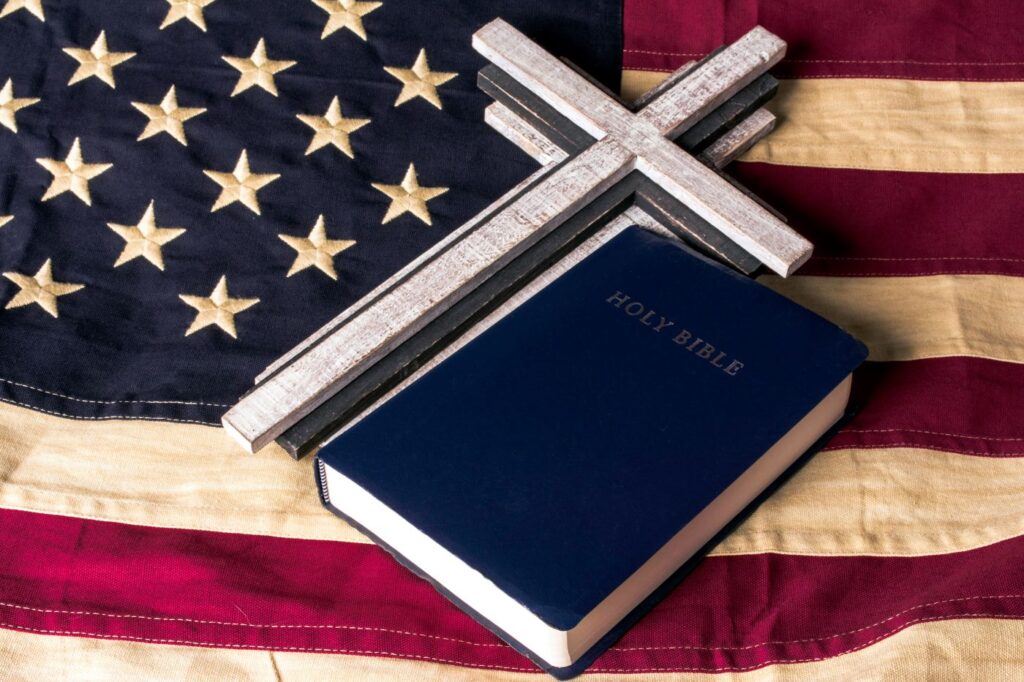In recent years, “Christian nationalism” has been among the greatest preoccupations of observers of American religion and politics, particularly those on the Left. Scholars in my home discipline of the sociology of religion have played a central role in sounding this alarm, lending an aura of social scientific legitimacy to the furor.
The empirical case for the reality and threat of Christian nationalism boils down to this: people who A) favor a closer relationship between Christianity and American public life are statistically more likely to hold attitudes reflecting B) religious or social conservatism, such as support for expansive religious liberty protections and opposition to abortion, and C) authoritarian ethnopopulism, such as distrust of ethnic and religious minorities, tolerance of political violence, or support for robust police powers. From this, several sociologists conclude that A, B, and C are all part of the same general phenomenon, with C functioning as the core of that phenomenon and the animating force behind both A and B.
In their primer on white Christian nationalism (the “white” is an inconsistently applied modifier), Philip Gorski and Samuel Perry summarize the proposed phenomenon. “The general principle is this: white men must sometimes exercise righteous violence to defend (their) freedom and maintain social (and racial) order,” they explain. “It is freedom for ‘us’ and authoritarian social order for ‘them.’” Across their many writings, proponents of this account implicate virtually every facet of the political Right in this sinister project. I will therefore refer to it as “the reductionistic account” of Christian nationalism.
Objections to Reductive Christian Nationalism
Start your day with Public Discourse
Sign up and get our daily essays sent straight to your inbox.Some religious conservative commentators, typically those who affirm B and some version of A while rejecting C, have raised objections. They insist that the reductionistic account does not describe their political commitments or those of most people in their religious communities. They do support a national self-understanding rooted in a (Judeo-)Christian tradition but emphasize that this tradition is inclusive, nonsectarian, and ultimately promotive of religious liberty and other principles of American liberal democracy. These commentators readily acknowledge that many Americans combine religion and right-wing politics in toxic ways, but argue that their own religious conservative commitments are distinct from and antithetical to the kind of authoritarian ethnopopulism of the reductionistic account.
As it happens, some social scientists who study religion share in these misgivings, and several studies in recent years have provided critiques, correctives, or alternative perspectives on Christian nationalism. These have occurred to little fanfare. They have been comparatively few and disparate, and authored by scholars less public-facing than the media-savvy proponents of the reductionistic account. Yet taken together, these studies offer substantial reason to doubt the reductionistic theory and suggest the objections of religious conservative commentators are well founded.
Taken together, these studies offer substantial reason to doubt the reductionistic theory and suggest the objections of religious conservative commentators are well founded.
Christian Statism vs. Religious Nationalism
The most recent entrant is a publication from Baylor’s Riquian Li and Paul Froese. Providing a deep statistical dissection of the infamous six-question “Christian nationalism” scale, they find that it appears to capture not one empirical dimension, but two. They label the first of these dimensions “Christian statism,” reflected in the beliefs that the federal government should declare the United States a Christian nation and expressly promote Christian values. The second is “religious traditionalism,” reflected in the more ecumenical beliefs that religious symbolism should be permitted on public property and children should be allowed to pray in public schools. Li and Froese argue that where Christian statism favors an explicitly Christian state, religious traditionalism instead seeks a religiously grounded society. These are important distinctions because while the first seeks to use the levers of state power to privilege white Christians over other groups, the second seeks instead to build a cultural consensus around a more inclusive and pluralistic vision of American democracy, albeit one that favors the moral sensibilities of religious conservatives.
Li and Froese further examine how each of these dimensions is linked to attitudes toward a variety of social groups, finding sharp differences. Christian statists are more likely to report feeling threatened by immigrants, Muslims, Jews, and even Buddhists, and are less trusting of racial minorities and people in general. Traditionalists, in contrast, tend to feel warmly toward immigrants and Jews (they are ambivalent about Muslims and Buddhists) and show high levels of trust toward others. In other ways, the two are similar. Each is more likely to say whites and Christians face discrimination while blacks do not, and each is distrustful of atheists. These results point to a Christian statism that lines up with accounts of Christian nationalism, but also a distinct strand of religious traditionalism that largely aligns with the religious conservative self-understanding.
Relatedly, three empirical studies explore how Christian nationalism (as measured by the aforementioned six-item scale) operates differently for those who are more versus less religious. Samuel Stroope and his coauthors show that among the unchurched, Christian nationalism is highly predictive of both anti-immigrant views and a 2016 vote for Donald Trump. For regular churchgoers, this relationship is weaker for immigrant attitudes and disappears entirely for 2016 vote choice. Taking a more psychological perspective, Laura Upenieks shows that Christian nationalism is associated with symptoms of depression only for those with low levels of religious commitment.
The general conclusion from these studies is that among the religiously disconnected, calls for a Christian nation stem from anxieties over declining social status and cultural resentment against perceived outsiders, whereas for churchgoers they instead reflect a desire to sustain a particular moral and religious vision of American culture. In short, the unchurched idea of a Christian nation more closely resembles the reductionistic account of Christian nationalism, whereas the churched version looks more like religious conservatism—though it should be noted in fairness that evidence for this distinction is mixed.
“Fight” vs. “Flight”
These studies employ quantitative analyses of survey data, an approach that carries many advantages but also some pitfalls. Survey questions can be imprecise, and raw numbers leave a lot of room for researchers to impose their preferred interpretations. However, scholarship applying qualitative methodology has arrived at similar conclusions. In an underappreciated contribution, Michael Rotolo analyzes interviews on religious beliefs from nearly 300 young adults to see who was using “God and country” rhetoric and how they were using it. He identifies two very different “Christian nationalist” profiles, which he labels “fight-for-America” and “flight-for-America.” People in the first group tend to be angrier, less religiously observant or knowledgeable, and more given to racial resentment and anti-government hostility. Their invocation of Christian nationalism seems to have less to do with religious doctrines than a general sense that the country is slipping away from them and a desire to lend a religious justification to their resentments. The “flight-for-America” profile stands in stark contrast. People in this group are religiously observant and socially conservative, and they tend to exhibit anxiety over declining moral standards rather than anger at declining social status. The Christian nation they invoke is set against what they see as increasingly pervasive moral relativism. Once again, we see two ideological strands, one reflecting Christian nationalism and the other, religious conservatism.
Conflicting Narratives
Finally, Ruth Braunstein provides a novel and informative approach to the study of Christian nationalism. In an analysis focused on history and public discourse rather than individual attitudes, she examines variations in “Christian nation” narratives on the political Right. She identifies a distinction, and tension, between two prominent conservative narratives: “white Christian nationalism” (WCN) on one hand, and “colorblind Judeo-Christian nationalism” (CJCN) on the other.
Each tells a tale of national decline and calls for a restoration. But while the WCN narrative laments the lost social power and status of white Christians and prescribes militant political action to combat the alleged marginalization of these “true Americans,” the CJCN narrative exalts the liberal democratic ideals of the founding era and calls for a restoration of the inclusive religious values believed to sustain these ideals. This inclusion reaches a limit when it comes to secularists, communists, Muslims, or other groups perceived as a threat to religious consensus, but nonetheless outwardly claims to embrace people of all races and many faiths. The use of the CJCN narrative on the Right reflects a direct effort to establish inclusivity and create a boundary against right-wing extremism.
Taken together, these studies highlight the weaknesses of the reductionistic account of Christian nationalism and largely vindicate the concerns of its critics.
Imperfect Ideologies
Taken together, these studies highlight the weaknesses of the reductionistic account of Christian nationalism and largely vindicate the concerns of its critics. Religious conservative commentators insist that their political and religious commitments are distinct from the authoritarian ethnopopulism dominating the headlines, and social scientific evidence confirms the distinction. In light of this research, the sweeping and bombastic application of the “Christian nationalist” label should increasingly be viewed as ideological rather than social scientific in nature, the participation of prominent sociologists notwithstanding. As I have argued at length, the reductionistic account was never very coherent or plausible as a sociological theory. And as a general rule, any research agenda whose primary claim is that its authors’ political opponents possess corrupted motivations and malign intentions should be viewed with considerable skepticism.
None of this is to say that these corrective studies offer religious conservatives a clean bill of health. Just because Christian nationalism and religious conservatism are theoretically and empirically separable does not mean that they are in fact cleanly separated. Given the high correlations between these dimensions, we might instead picture a substantially overlapping Venn diagram. This suggests despite explicitly rejecting racial prejudice, religious conservatives have not been wholly effective in policing tendencies toward populism or racial resentment in their ranks. Furthermore, the results of these studies suggest that while colorblindness and individualism among religious conservatives may serve as checks on overt racism, they also breed resistance to recognizing and grappling with the country’s racial sins. The result is a delimited moral vision and set of policy preferences that place a political wedge between white and black Christians who otherwise have a great deal in common.
Various trends in American religion and right-wing politics further indicate that as the political influence of Christian nationalism is waxing, that of religious conservatism is waning. This need not be a fixed situation, but it does mean religious conservatives will have ample need of God’s grace as they consider how to avoid moral and spiritual compromise while navigating a particularly treacherous political landscape.
Image by zenmaster8 and licensed via Adobe Stock. Image resized.














